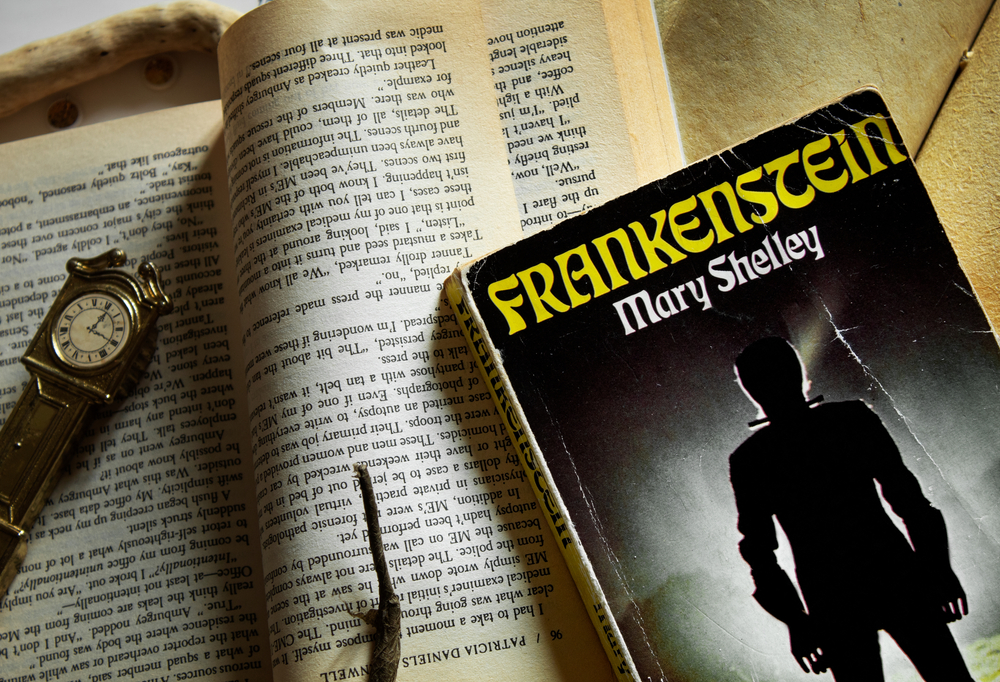
Did you know that the invention of the very first electrocardiograms, external defibrillators, and implantable cardiac pacemakers may have been inspired by the story of Frankenstein? This monster may have helped save millions of lives. The late Medtronic founder, Earl Bakken, was intrigued when, as an eight-year-old child, he watched over and over Mary Shelley’s adaptation of her 1818 novel Frankenstein or The Modern Prometheus into a movie in 1931. “What intrigued me the most, as I sat through the movie again and again,” Bakken said, “was the creative spark of Dr. Frankenstein’s electricity. Through the power of his wildly flashing laboratory apparatus, the doctor restored life to the unliving.” Science fiction inspired science reality with the eventual development of electrocardiograms (ECGs) and external defibrillators, and eventually pacemakers.
Earl Bakken and his brother-in-law, Palmer Hermundslie, started Medtronic in 1949 and focused on medical electronics. Bakken was inspired to make use of electrical devices to preserve life. Following a winter storm in 1957 in Minneapolis, MN (USA), the power went out endangering the lives of open-heart surgery patients who were often attached to a pacemaker. A heart surgeon at the University of Minnesota asked Bakken if he could create a battery pacemaker, and four weeks later, he did just that. Hermundslie, a pilot, flew all over the USA delivering pacemakers. Fascination with the connection between electricity, sparks, and life eventually led to the invention of wearable, portable pacemakers.
Here are Other Sparks that are Stimulating the Development of Novel Medical Devices
 Today’s medical devices connect to the internet and allow clinicians to monitor medical conditions remotely, giving patients greater freedom. This technology opens the door to possibility and risk alike. Here are some trends that are changing the game for the medical device industry right now.
Today’s medical devices connect to the internet and allow clinicians to monitor medical conditions remotely, giving patients greater freedom. This technology opens the door to possibility and risk alike. Here are some trends that are changing the game for the medical device industry right now.
Artificial Intelligence and Machine Learning
Technology is transforming all industries, and it is inspiring. Steve Jobs is quoted as saying, “Stay hungry. Stay foolish. Never let go of your appetite to go after new ideas, new experiences, and new adventures.” Artificial intelligence (AI) and machine learning (ML) will be the next big thing in medical devices. Will it be a new adventure for you too?
https://www.linkedin.com/pulse/hey-artificial-intelligence-lets-foolish-friends-david-rutledge/
AI and ML was both a new idea and adventure for me, but I had to learn this new language. The potential was immediately evident to me: applications to diagnose conditions, identify diseases, guide therapies, recognize trends, and even create efficiencies within clinical trial processes. However, device regulators worldwide were struggling, partly because laws and regulations had to be updated to allow this technology to reach its full potential. Many regulatory bodies initiated pilot programs with the hopes of collecting evidence (data) that could be used to update these regulations.
The FDA authorized an AI-based device to detect diabetic retinopathy, an eye disease that can cause vision loss. The agency also authorized a second artificial intelligence-based device for alerting providers of a potential stroke in patients. Others will follow.

AI and ML are suitable for large data sets where patterns are difficult to find using human intelligence alone. AI is good at understanding interactions. The challenge is to ask a specific, relevant question. Nisha Talagala is the CEO of Pyxeda AI here in Silicon Valley, and she provides her perspective on AI’s future potential:
“AI has tremendous potential for medical devices, with applications ranging from diagnostic assistance to personalized health, preventative care, and holistic wellness. The AI industry is maturing and moving from a research-oriented phase to broader commercial impact, driven by innovations in cloud tools and automation.
Programs like http://aiclub.world, enabling individuals of varied domains and expertise levels to learn and apply AI to their fields, accelerate the broad production value of this transformational technology.”
Because medical devices using AI and ML rely on software algorithms that continually learn and adapt, developers must ensure their models are appropriately validated and documented.
Interest in medical devices incorporating this functionality has increased in recent years. Over the past decade, the FDA, for example, has reviewed and authorized a growing number of devices legally marketed [via 510(k) clearance, granted De Novo request, or approved PMA] with ML across many different fields of medicine—and they expect this trend to continue.
The FDA provides this initial list of AI/ML-enabled medical devices marketed in the United States as a resource to the public about these devices and the FDA’s work in this area. Click on the link and hold on; you will be amazed at what has been accomplished in a few short years.
Wearable Tech to Monitor Biometrics
From fitness trackers to Wi-Fi-connected yoga pants, the market for wearables is trending big right now. These devices can count steps, monitor heart rate, and even detect cancer. And with the popularity of virtual visits, which look like they will be here to stay in healthcare, wearables will become an increasingly important diagnostic tool. Devices like Fitbits, video glasses, and smartwatches are also being included in decentralized (or agile) clinical trials (DCTs). Many devices are creating unique patient outcome parameters. Some of these new, novel outcomes are proprietary, that will need to be verified and validated against more traditional outcomes such as vital signs, six-minute walk tests, walking or gait scales, or simply physical activity. When working with medical device regulators, it is best not to use proprietary outcomes because they will need transparency to assess safety, performance, and effectiveness before approval.

FDA and EMA have qualified some wearables to be used in clinical research, and we should see this expand rapidly over the next three years. As part of the FDA draft guidance on Heart Failure (June 2019), the agency states, “Endpoints acceptable to FDA included individual symptoms or a composite symptom score, exercise capacity, functional capacity, New York Heart Association functional class, and measures of activity/daily living. FDA will consider trials that use novel endpoints, including other clinical outcome assessments, other measures of functional capacity, and measures of daily activity, e.g., accelerometry data.” What manufacturer would not want better patient experiences, retention in clinical trials, and faster recruitment?
Today’s technology is about monitoring fitness with watches and clothing. But over the next decade, your earrings might be able to tell you what supplements to take based on the nutrition you consumed that day. Or your health condition might be monitored through your fingernail polish, a wearable chain or necklace, or socks.
Related: The Most Common Manufacturing ISO Standards for Medical Devices
Robotic Surgery
When you believe in yourself, your team, and the available technologies, brilliant and unique results are at your fingertips. The ability to perform minimally invasive surgeries remotely was thought to be impossible. These procedures required both rapid and accurate transmission of information. Factors once thought to be impossible to overcome, the time necessary to convert video images and gestures into electronic signals, and the bandwidth requirements to decrease time lag were obstacles critics often cited. Robot-assisted remote telesurgery, although theoretically possible, had not been proven. Enter Professor Jacques Marescaux and his team from the French-based Institute for Research into Cancer of the Digestive System.

On September 7, 2001, he and his team performed the first transcontinental (transatlantic, in fact) laparoscopic operation, from New York, on a patient in Strasbourg, France, over a distance of several thousand miles. A 68-year-old woman with a history of recurrent abdominal pain in the right hypochondrium and epigastrium underwent abdominal ultrasound documenting the presence of cholelithiasis. He and Canadian-born surgeon Michel Gagner performed a remote telesurgical cholecystectomy operation or gallbladder removal surgery using the sophisticated Zeus surgical robot. This procedure was christened the “Lindbergh operation.” The name was derived from the American aviator Charles Lindbergh because he was the first person to fly solo across the Atlantic Ocean.
This was the first time in medical history that a technical solution proved capable of reducing the time delay inherent to long-distance transmissions sufficiently to make this type of procedure possible.
Professor Jacques Marescaux and his team showed the world that robot-assisted remote telesurgery could be safely conducted across transoceanic distances. The ability to perform complex surgical manipulations from remote locations would eliminate geographical constraints and make surgical expertise available throughout the world, improve patient treatment, encourage an explosion in technology advancements, and even change how surgical training can be performed.

Robotics make surgery possible with machine precision, offering less-invasive surgical options and faster recovery times. Robots perform or augment the surgical experience, providing ergonomic support for stability, agility, and dexterity during complicated procedures. We are on the precipice of significant advancements in healthcare robotics, including:
- Diagnostic Microbots
- Minimally-Invasive Surgery
- Robot-Aided Physical Therapy
- Administrative & Sanitation Support
- High-Tech Prosthetics
- Telemedicine
What other companies are now “sparking” medical device innovations?
Twelve Surgical Robotics Companies to Watch
- Intuitive Surgical (da Vinci)
- Medtronic (Hugo)
- Johnson & Johnson (Ottava)
- Stryker (Mako)
- Siemens (Corindus)
- Asensus Surgical (Senhance)
- Titan Medical (Sport)
- Stereotaxis (Genesis)
- Smith+Nephew (Cori)
- Zimmer Biomet (Rosa)
- Vicarious Surgical (Vicarious)
- Monteris Medical (NeuroBlate)
Augmented Reality
 Augmented Reality helps surgeons gather data in 3D format, which aids in surgery planning and patient treatments. It can also help explain complex medical procedures to enhance their patients’ and their families’ understanding and expectations.
Augmented Reality helps surgeons gather data in 3D format, which aids in surgery planning and patient treatments. It can also help explain complex medical procedures to enhance their patients’ and their families’ understanding and expectations.
According to BIS Research, the global market for augmented and virtual reality in healthcare is expected to grow to $11.4 billion by 2025.
Global Strategic Solutions is an experienced international consultant for the medical field. We can help get your medical device invention patented or approved for sale. Learn more today.
Final Thoughts
The healthcare industry is changing at a rapid pace. Some of this change is driven by the evolution of the business of healthcare. And some are driven by technology. Innovations in medical devices are a big part of this change. Medical devices are changing the way that patients see the clinician. They are adding precision to diagnostics, surgery, and point-of-care. There is no nook or cranny in the healthcare system that is not experiencing a change. And we’ll be able to deliver more efficient and effective healthcare because of it.

The late Medtronic founder Earl Bakken’s inspirational story of watching how electrical sparks in the movie Frankenstein inspired the creation of technologies that saved millions of lives is one of many personal testimonies. What will be your “spark”? With the proper education, training, skills, and experiences, you too can encourage the development of novel devices of the future. You can make a difference. Would you mind sharing your inspiring thoughts below? They might be that spark that encourages others to pursue their passion and change the world.
Global Strategic Solutions is committed to ensuring safety in the medical field through effective risk management consultation. If you need clinical, regulatory, or quality support, we have the skills and experience that you need to navigate the medical device development process.

